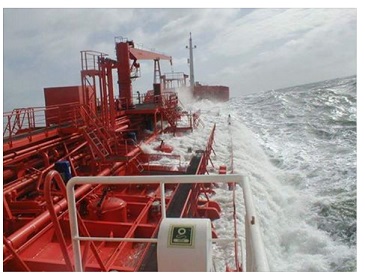Have all movable objects everywhere onboard (on deck, in the engine room, stores, accommodation, galley, etc.) been securely fixed? Has ballast been adjusted to reduce the free surface effect and are draft, trim, and stability conditions adequate? Have you inspected anchor stowage, lashing, and stoppers of anchors and chain? Have brakes of the windlass been extra tightened and mooring wires and ropes been well secured? Are two power units for the steering gear running?
Has the vessel's course and speed been adjusted as necessary (on masters orders), to minimize adverse effects of heavy weather? Has crew been warned to not go out on weather deck without permission? Moreover, is permission granted only after appraising the situation, adjusting course (on masters orders) if required? Have safety ropes and hand ropes been arranged where necessary (if required)? Consideration of loading Heavy weather ballast in cargo Tanks? Have instructions been given on:
Keeping watch on weather reports (monitoring) &
Transmitting weather reports, or danger message (in case of tropical storm) as per SOLAS V/2a Any additional instructions from the Master
The master's action
If possible, the Master shall select a reasonable route that allows the vessel to avoid navigation in heavy weather or keep a safe distance from the storm center.
The Master must regulate speed and alter course in heavy weather, as required by good seamanship, to avoid the possibility of damage to ship and cargo and avoid the needless fuel expenditure.
Reduction of a few revolutions will make a considerable difference to the motion of the ship, but very little difference in voyage time.
When he judges that the vessel will be in heavy weather, the Master shall take necessary countermeasures as per above mentioned "Navigation in Heavy Weather Checklist."
If the vessel is available to use a specific cargo tank designated for Heavy Weather Ballasting, and the Master considers it necessary to do so due to inadequate draft, he shall inform management. Company. Also, he shall take all necessary precautions for this Ballasting and De-ballasting process.
Inspection before entering and after leaving heavy weather
The Master shall inspect the vessel and cargo during navigation in (if practicable) and just after heavy weather conditions and advise Company if any damage has occurred.
Any possible (even if temporary) repairs by ship staff either to the Hull, Fittings, or the Cargo (Containers) must be attempted by ship staff as soon as weather abates.
Recommended publications for more info:
-
Mariners handbook NP 100
-
Guide to ocean passage for the world
-
Admiralty sailing directions
Related Information
Ships power failure emergency action
Safety of navigation in Singapore strait
Action by vessels navigating in an area of restricted visibility
Collecting Information and Data for Passage Planning

